Hanting Chen
and Other Contributors
Revealing the Power of Post-Training for Small Language Models via Knowledge Distillation
Sep 30, 2025Abstract:The rapid advancement of large language models (LLMs) has significantly advanced the capabilities of artificial intelligence across various domains. However, their massive scale and high computational costs render them unsuitable for direct deployment in resource-constrained edge environments. This creates a critical need for high-performance small models that can operate efficiently at the edge. Yet, after pre-training alone, these smaller models often fail to meet the performance requirements of complex tasks. To bridge this gap, we introduce a systematic post-training pipeline that efficiently enhances small model accuracy. Our post training pipeline consists of curriculum-based supervised fine-tuning (SFT) and offline on-policy knowledge distillation. The resulting instruction-tuned model achieves state-of-the-art performance among billion-parameter models, demonstrating strong generalization under strict hardware constraints while maintaining competitive accuracy across a variety of tasks. This work provides a practical and efficient solution for developing high-performance language models on Ascend edge devices.
Rethinking 1-bit Optimization Leveraging Pre-trained Large Language Models
Aug 09, 2025Abstract:1-bit LLM quantization offers significant advantages in reducing storage and computational costs. However, existing methods typically train 1-bit LLMs from scratch, failing to fully leverage pre-trained models. This results in high training costs and notable accuracy degradation. We identify that the large gap between full precision and 1-bit representations makes direct adaptation difficult. In this paper, we introduce a consistent progressive training for both forward and backward, smoothly converting the floating-point weights into the binarized ones. Additionally, we incorporate binary-aware initialization and dual-scaling compensation to reduce the difficulty of progressive training and improve the performance. Experimental results on LLMs of various sizes demonstrate that our method outperforms existing approaches. Our results show that high-performance 1-bit LLMs can be achieved using pre-trained models, eliminating the need for expensive training from scratch.
Pangu DeepDiver: Adaptive Search Intensity Scaling via Open-Web Reinforcement Learning
May 30, 2025Abstract:Information seeking demands iterative evidence gathering and reflective reasoning, yet large language models (LLMs) still struggle with it in open-web question answering. Existing methods rely on static prompting rules or training with Wikipedia-based corpora and retrieval environments, limiting adaptability to the real-world web environment where ambiguity, conflicting evidence, and noise are prevalent. These constrained training settings hinder LLMs from learning to dynamically decide when and where to search, and how to adjust search depth and frequency based on informational demands. We define this missing capacity as Search Intensity Scaling (SIS)--the emergent skill to intensify search efforts under ambiguous or conflicting conditions, rather than settling on overconfident, under-verification answers. To study SIS, we introduce WebPuzzle, the first dataset designed to foster information-seeking behavior in open-world internet environments. WebPuzzle consists of 24K training instances and 275 test questions spanning both wiki-based and open-web queries. Building on this dataset, we propose DeepDiver, a Reinforcement Learning (RL) framework that promotes SIS by encouraging adaptive search policies through exploration under a real-world open-web environment. Experimental results show that Pangu-7B-Reasoner empowered by DeepDiver achieve performance on real-web tasks comparable to the 671B-parameter DeepSeek-R1. We detail DeepDiver's training curriculum from cold-start supervised fine-tuning to a carefully designed RL phase, and present that its capability of SIS generalizes from closed-form QA to open-ended tasks such as long-form writing. Our contributions advance adaptive information seeking in LLMs and provide a valuable benchmark and dataset for future research.
Pangu Embedded: An Efficient Dual-system LLM Reasoner with Metacognition
May 29, 2025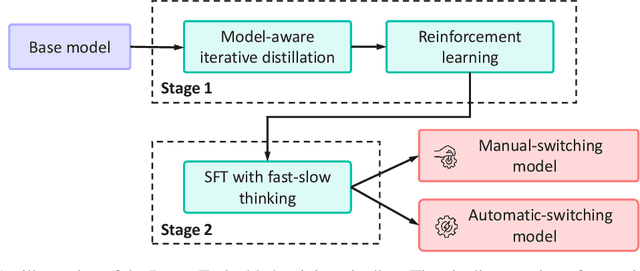
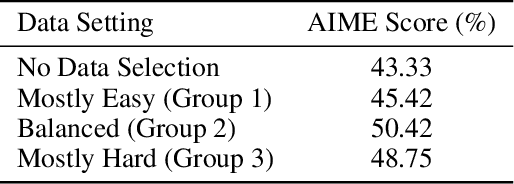


Abstract:This work presents Pangu Embedded, an efficient Large Language Model (LLM) reasoner developed on Ascend Neural Processing Units (NPUs), featuring flexible fast and slow thinking capabilities. Pangu Embedded addresses the significant computational costs and inference latency challenges prevalent in existing reasoning-optimized LLMs. We propose a two-stage training framework for its construction. In Stage 1, the model is finetuned via an iterative distillation process, incorporating inter-iteration model merging to effectively aggregate complementary knowledge. This is followed by reinforcement learning on Ascend clusters, optimized by a latency-tolerant scheduler that combines stale synchronous parallelism with prioritized data queues. The RL process is guided by a Multi-source Adaptive Reward System (MARS), which generates dynamic, task-specific reward signals using deterministic metrics and lightweight LLM evaluators for mathematics, coding, and general problem-solving tasks. Stage 2 introduces a dual-system framework, endowing Pangu Embedded with a "fast" mode for routine queries and a deeper "slow" mode for complex inference. This framework offers both manual mode switching for user control and an automatic, complexity-aware mode selection mechanism that dynamically allocates computational resources to balance latency and reasoning depth. Experimental results on benchmarks including AIME 2024, GPQA, and LiveCodeBench demonstrate that Pangu Embedded with 7B parameters, outperforms similar-size models like Qwen3-8B and GLM4-9B. It delivers rapid responses and state-of-the-art reasoning quality within a single, unified model architecture, highlighting a promising direction for developing powerful yet practically deployable LLM reasoners.
Pangu Pro MoE: Mixture of Grouped Experts for Efficient Sparsity
May 28, 2025Abstract:The surgence of Mixture of Experts (MoE) in Large Language Models promises a small price of execution cost for a much larger model parameter count and learning capacity, because only a small fraction of parameters are activated for each input token. However, it is commonly observed that some experts are activated far more often than others, leading to system inefficiency when running the experts on different devices in parallel. Therefore, we introduce Mixture of Grouped Experts (MoGE), which groups the experts during selection and balances the expert workload better than MoE in nature. It constrains tokens to activate an equal number of experts within each predefined expert group. When a model execution is distributed on multiple devices, this architectural design ensures a balanced computational load across devices, significantly enhancing throughput, particularly for the inference phase. Further, we build Pangu Pro MoE on Ascend NPUs, a sparse model based on MoGE with 72 billion total parameters, 16 billion of which are activated for each token. The configuration of Pangu Pro MoE is optimized for Ascend 300I Duo and 800I A2 through extensive system simulation studies. Our experiments indicate that MoGE indeed leads to better expert load balancing and more efficient execution for both model training and inference on Ascend NPUs. The inference performance of Pangu Pro MoE achieves 1148 tokens/s per card and can be further improved to 1528 tokens/s per card by speculative acceleration, outperforming comparable 32B and 72B Dense models. Furthermore, we achieve an excellent cost-to-performance ratio for model inference on Ascend 300I Duo. Our studies show that Ascend NPUs are capable of training Pangu Pro MoE with massive parallelization to make it a leading model within the sub-100B total parameter class, outperforming prominent open-source models like GLM-Z1-32B and Qwen3-32B.
Pangu Light: Weight Re-Initialization for Pruning and Accelerating LLMs
May 26, 2025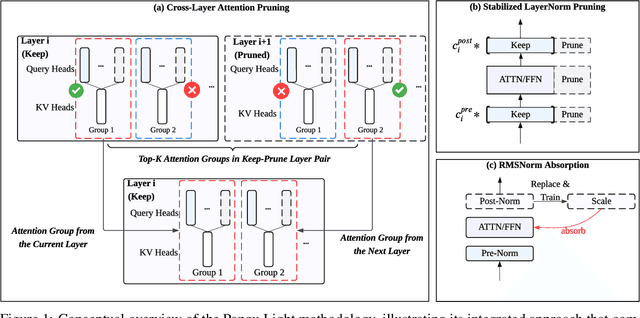

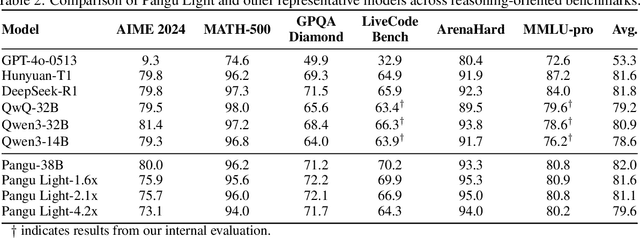
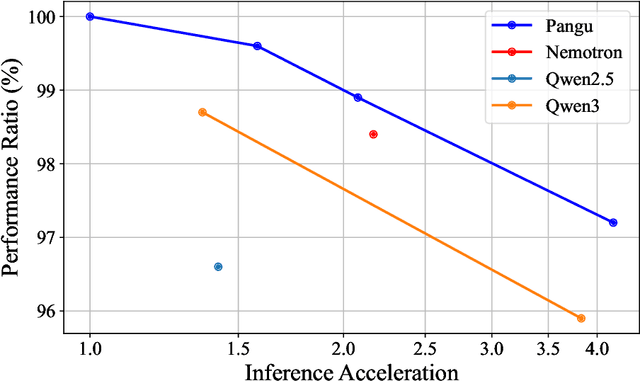
Abstract:Large Language Models (LLMs) deliver state-of-the-art capabilities across numerous tasks, but their immense size and inference costs pose significant computational challenges for practical deployment. While structured pruning offers a promising avenue for model compression, existing methods often struggle with the detrimental effects of aggressive, simultaneous width and depth reductions, leading to substantial performance degradation. This paper argues that a critical, often overlooked, aspect in making such aggressive joint pruning viable is the strategic re-initialization and adjustment of remaining weights to improve the model post-pruning training accuracies. We introduce Pangu Light, a framework for LLM acceleration centered around structured pruning coupled with novel weight re-initialization techniques designed to address this ``missing piece''. Our framework systematically targets multiple axes, including model width, depth, attention heads, and RMSNorm, with its effectiveness rooted in novel re-initialization methods like Cross-Layer Attention Pruning (CLAP) and Stabilized LayerNorm Pruning (SLNP) that mitigate performance drops by providing the network a better training starting point. Further enhancing efficiency, Pangu Light incorporates specialized optimizations such as absorbing Post-RMSNorm computations and tailors its strategies to Ascend NPU characteristics. The Pangu Light models consistently exhibit a superior accuracy-efficiency trade-off, outperforming prominent baseline pruning methods like Nemotron and established LLMs like Qwen3 series. For instance, on Ascend NPUs, Pangu Light-32B's 81.6 average score and 2585 tokens/s throughput exceed Qwen3-32B's 80.9 average score and 2225 tokens/s.
EAM: Enhancing Anything with Diffusion Transformers for Blind Super-Resolution
May 08, 2025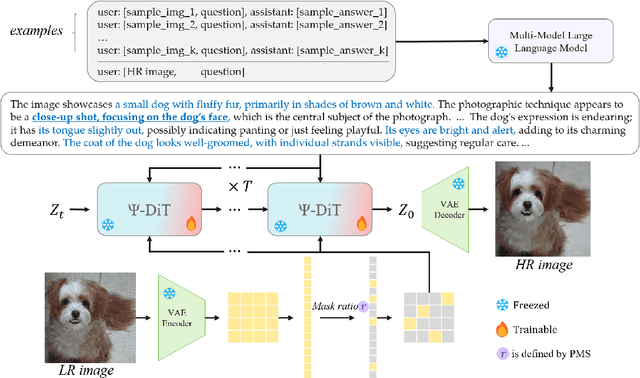
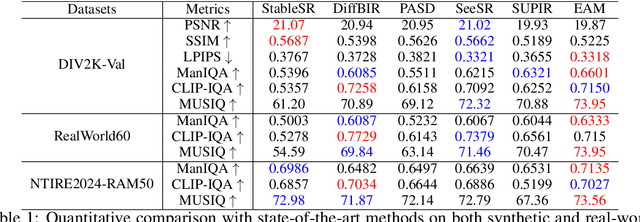
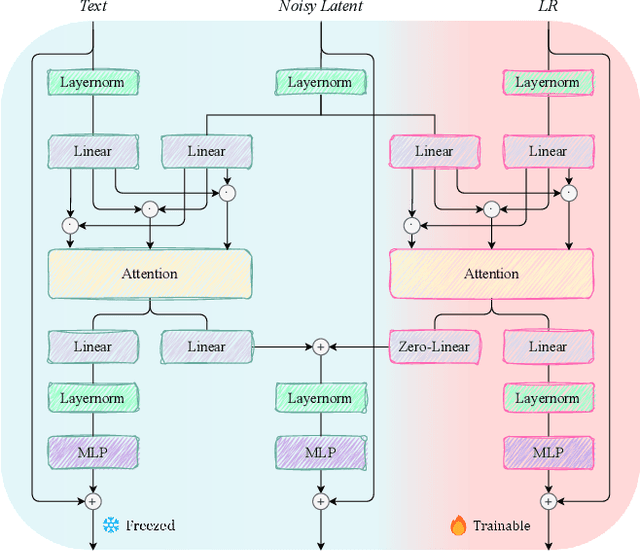

Abstract:Utilizing pre-trained Text-to-Image (T2I) diffusion models to guide Blind Super-Resolution (BSR) has become a predominant approach in the field. While T2I models have traditionally relied on U-Net architectures, recent advancements have demonstrated that Diffusion Transformers (DiT) achieve significantly higher performance in this domain. In this work, we introduce Enhancing Anything Model (EAM), a novel BSR method that leverages DiT and outperforms previous U-Net-based approaches. We introduce a novel block, $\Psi$-DiT, which effectively guides the DiT to enhance image restoration. This block employs a low-resolution latent as a separable flow injection control, forming a triple-flow architecture that effectively leverages the prior knowledge embedded in the pre-trained DiT. To fully exploit the prior guidance capabilities of T2I models and enhance their generalization in BSR, we introduce a progressive Masked Image Modeling strategy, which also reduces training costs. Additionally, we propose a subject-aware prompt generation strategy that employs a robust multi-modal model in an in-context learning framework. This strategy automatically identifies key image areas, provides detailed descriptions, and optimizes the utilization of T2I diffusion priors. Our experiments demonstrate that EAM achieves state-of-the-art results across multiple datasets, outperforming existing methods in both quantitative metrics and visual quality.
DSPO: Direct Semantic Preference Optimization for Real-World Image Super-Resolution
Apr 21, 2025Abstract:Recent advances in diffusion models have improved Real-World Image Super-Resolution (Real-ISR), but existing methods lack human feedback integration, risking misalignment with human preference and may leading to artifacts, hallucinations and harmful content generation. To this end, we are the first to introduce human preference alignment into Real-ISR, a technique that has been successfully applied in Large Language Models and Text-to-Image tasks to effectively enhance the alignment of generated outputs with human preferences. Specifically, we introduce Direct Preference Optimization (DPO) into Real-ISR to achieve alignment, where DPO serves as a general alignment technique that directly learns from the human preference dataset. Nevertheless, unlike high-level tasks, the pixel-level reconstruction objectives of Real-ISR are difficult to reconcile with the image-level preferences of DPO, which can lead to the DPO being overly sensitive to local anomalies, leading to reduced generation quality. To resolve this dichotomy, we propose Direct Semantic Preference Optimization (DSPO) to align instance-level human preferences by incorporating semantic guidance, which is through two strategies: (a) semantic instance alignment strategy, implementing instance-level alignment to ensure fine-grained perceptual consistency, and (b) user description feedback strategy, mitigating hallucinations through semantic textual feedback on instance-level images. As a plug-and-play solution, DSPO proves highly effective in both one-step and multi-step SR frameworks.
A Physics-guided Multimodal Transformer Path to Weather and Climate Sciences
Apr 19, 2025Abstract:With the rapid development of machine learning in recent years, many problems in meteorology can now be addressed using AI models. In particular, data-driven algorithms have significantly improved accuracy compared to traditional methods. Meteorological data is often transformed into 2D images or 3D videos, which are then fed into AI models for learning. Additionally, these models often incorporate physical signals, such as temperature, pressure, and wind speed, to further enhance accuracy and interpretability. In this paper, we review several representative AI + Weather/Climate algorithms and propose a new paradigm where observational data from different perspectives, each with distinct physical meanings, are treated as multimodal data and integrated via transformers. Furthermore, key weather and climate knowledge can be incorporated through regularization techniques to further strengthen the model's capabilities. This new paradigm is versatile and can address a variety of tasks, offering strong generalizability. We also discuss future directions for improving model accuracy and interpretability.
Transferable text data distillation by trajectory matching
Apr 14, 2025

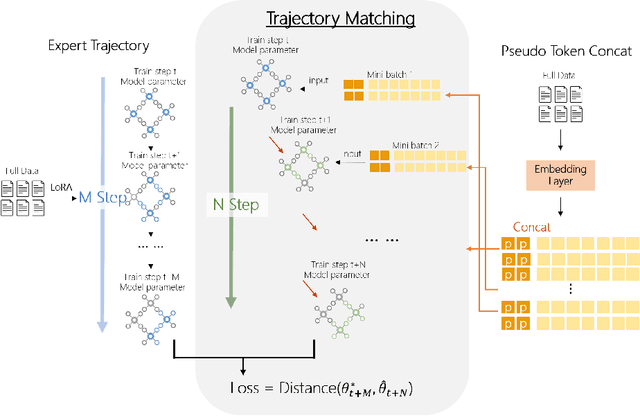
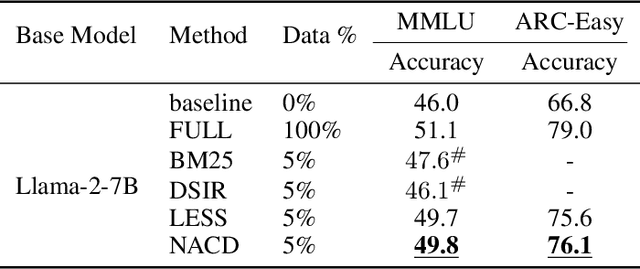
Abstract:In the realm of large language model (LLM), as the size of large models increases, it also brings higher training costs. There is a urgent need to minimize the data size in LLM training. Compared with data selection method, the data distillation method aims to synthesize a small number of data samples to achieve the training effect of the full data set and has better flexibility. Despite its successes in computer vision, the discreteness of text data has hitherto stymied its exploration in natural language processing (NLP). In this work, we proposed a method that involves learning pseudo prompt data based on trajectory matching and finding its nearest neighbor ID to achieve cross-architecture transfer. During the distillation process, we introduce a regularization loss to improve the robustness of our distilled data. To our best knowledge, this is the first data distillation work suitable for text generation tasks such as instruction tuning. Evaluations on two benchmarks, including ARC-Easy and MMLU instruction tuning datasets, established the superiority of our distillation approach over the SOTA data selection method LESS. Furthermore, our method demonstrates a good transferability over LLM structures (i.e., OPT to Llama).
 Add to Chrome
Add to Chrome Add to Firefox
Add to Firefox Add to Edge
Add to Edge